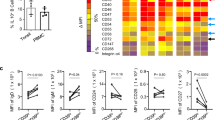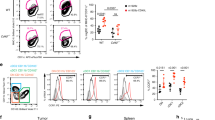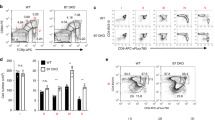Abstract
CD4+ regulatory T cells (Tregs) play an important role in maintaining immune tolerance by suppressing pathologic immune responses. The generation of large numbers of antigen-specific Tregs ex vivo is critical for the development of clinical immunotherapy based on the adoptive transfer of Tregs. Both CD40-activated B cells (CD40-B) and immature dendritic cells (imDCs) have been used as professional antigen-presenting cells (APCs) to generate antigen-specific Tregs. However, the efficiencies of CD40-B and imDCs to generate CD4+ Tregs have not been compared directly and the mechanism driving the generation of these Tregs remains largely unknown. In this study, we found that CD40-B exhibited mature phenotypes and were more able to induce and expand CD4highCD25+ Tregs than imDCs. Moreover, Tregs induced by CD40-B had greater suppressive capacity than those induced by imDCs. The generation of CD4highCD25+ Tregs by CD40-B and imDCs is cell–cell contact dependent and partially relies on the expression of human leukocyte antigen (HLA)-DR and CD80/86. Differences in CD4highCD25+ Treg generation efficiency were largely explained by the production of endogenous IL-2 by CD40-B. Our results suggest that CD40-B is better able to generate large numbers of antigen-specific Tregs than imDCs. Additionally, using CD40-B to generate Tregs may accelerate the clinical use of Treg-based immunotherapy in the treatment of allograft rejection, graft versus host disease (GVHD) and autoimmune diseases.
This is a preview of subscription content, access via your institution
Access options
Subscribe to this journal
Receive 12 digital issues and online access to articles
$119.00 per year
only $9.92 per issue
Buy this article
- Purchase on Springer Link
- Instant access to full article PDF
Prices may be subject to local taxes which are calculated during checkout







Similar content being viewed by others
References
Sakaguchi S, Yamaguchi T, Nomura T, Ono M . Regulatory T cells and immune tolerance. Cell 2008; 133: 775–787.
Toubi E . The role of CD4+CD25+ T regulatory cells in autoimmune diseases. Clin Rev Allergy Immunol 2008; 34: 338–344.
Lysaght J, Jarnicki AG, Mills KH . Reciprocal effects of Th1 and Treg cell inducing pathogen-associated immunomodulatory molecules on anti-tumor immunity. Cancer Immunol Immunother 2007; 56: 1367–1379.
Roux S, Apetoh L, Chalmin F, Ladoire S, Mignot G, Puig PE, et al. CD4CD25 Tregs control the TRAIL-dependent cytotoxicity of tumor-infiltrating DCs in rodent models of colon cancer. J Clin Invest 2008; 118: 3751–3761.
Waldmann H, Adams E, Fairchild P, Cobbold S . Regulation and privilege in transplantation tolerance. J Clin Immunol 2008; 28: 716–725.
Walsh PT, Taylor DK, Turka LA . Tregs and transplantation tolerance. J Clin Invest 2004; 114: 1398–1403.
Nguyen VH, Zeiser R, Dasilva DL, Chang DS, Beilhack A, Contag CH, et al. In vivo dynamics of regulatory T-cell trafficking and survival predict effective strategies to control graft-versus-host disease following allogeneic transplantation. Blood 2007; 109: 2649–2656.
Taylor PA, Panoskaltsis-Mortari A, Swedin JM, Lucas PJ, Gress RE, Levine BL, et al. L-selectin(hi) but not the L-selectin(lo) CD4+25+ T-regulatory cells are potent inhibitors of GVHD and BM graft rejection. Blood 2004; 104: 3804–3812.
Gil-Guerrero L, Dotor J, Huibregtse IL, Casares N, Lopez-Vazquez AB, Rudilla F, et al. In vitro and in vivo down-regulation of regulatory T cell activity with a peptide inhibitor of TGF-β1. J Immunol 2008; 181: 126–135.
Godfrey WR, Ge YG, Spoden DJ, Levine BL, June CH, Blazar BR, et al. In vitro-expanded human CD4+CD25+ T-regulatory cells can markedly inhibit allogeneic dendritic cell-stimulated MLR cultures. Blood 2004; 104: 453–461.
Hoffmann P, Eder R, Kunz-Schughart LA, Andreesen R, Edinger M . Large-scale in vitro expansion of polyclonal human CD4+CD25high regulatory T cells. Blood 2004; 104: 895–903.
Levings MK, Sangregorio R, Roncarolo MG . Human CD25+CD4+ T regulatory cells suppress naive and memory T cell proliferation and can be expanded in vitro without loss of function. J Exp Med 2001; 193: 1295–1302.
Shevach EM, Tran DQ, Davidson TS, Andersson J . The critical contribution of TGF-β to the induction of Foxp3 expression and regulatory T cell function. Eur J Immunol 2008; 38: 915–917.
Kang SM, Tang Q, Bluestone JA . CD4+CD25+ regulatory T cells in transplantation: progress, challenges and prospects. Am J Transplant 2007; 7: 1457–1463.
Salomon B, Lenschow DJ, Rhee L, Ashourian N, Singh B, Sharpe A, et al. B7/CD28 costimulation is essential for the homeostasis of the CD4+CD25+ immunoregulatory T cells that control autoimmune diabetes. Immunity 2000; 12: 431–440.
Coombes JL, Siddiqui KR, Arancibia-Carcamo CV, Hall J, Sun CM, Belkaid Y, et al. A functionally specialized population of mucosal CD103+ DCs induces Foxp3+ regulatory T cells via a TGF-β and retinoic acid-dependent mechanism. J Exp Med 2007; 204: 1757–1764.
Ito T, Yang M, Wang YH, Lande R, Gregorio J, Perng OA, et al. Plasmacytoid dendritic cells prime IL-10-producing T regulatory cells by inducible costimulator ligand. J Exp Med 2007; 204: 105–115.
Kang HK, Liu M, Datta SK . Low-dose peptide tolerance therapy of lupus generates plasmacytoid dendritic cells that cause expansion of autoantigen-specific regulatory T cells and contraction of inflammatory Th17 cells. J Immunol 2007; 178: 7849–7858.
Yamazaki S, Dudziak D, Heidkamp GF, Fiorese C, Bonito AJ, Inaba K, et al. CD8+ CD205+ splenic dendritic cells are specialized to induce Foxp3+ regulatory T cells. J Immunol 2008; 181: 6923–6933.
Tu W, Lau YL, Zheng J, Liu Y, Chan PL, Mao H, et al. Efficient generation of human alloantigen-specific CD4+ regulatory T cells from naive precursors by CD40-activated B cells. Blood 2008; 112: 2554–2562.
Zheng J, Liu Y, Qin G, Chan PL, Mao H, Lam KT, et al. Efficient induction and expansion of human alloantigen-specific CD8 regulatory T cells from naive precursors by CD40-activated B cells. J Immunol 2009; 183: 3742–3750.
Jonuleit H, Schmitt E, Schuler G, Knop J, Enk AH . Induction of interleukin 10-producing, nonproliferating CD4+ T cells with regulatory properties by repetitive stimulation with allogeneic immature human dendritic cells. J Exp Med 2000; 192: 1213–1222.
Qin G, Mao H, Zheng J, Sia SF, Liu Y, Chan PL, et al. Phosphoantigen-expanded human gammadelta T cells display potent cytotoxicity against monocyte-derived macrophages infected with human and avian influenza viruses. J Infect Dis 2009; 200: 858–865.
Gad M, Kristensen NN, Kury E, Claesson MH . Characterization of T-regulatory cells, induced by immature dendritic cells, which inhibit enteroantigen-reactive colitis-inducing T-cell responses in vitro and in vivo. Immunology 2004; 113: 499–508.
Schultze JL, Michalak S, Seamon MJ, Dranoff G, Jung K, Daley J, et al. CD40-activated human B cells: an alternative source of highly efficient antigen presenting cells to generate autologous antigen-specific T cells for adoptive immunotherapy. J Clin Invest 1997; 100: 2757–2765.
von Bergwelt-Baildon MS, Vonderheide RH, Maecker B, Hirano N, Anderson KS, Butler MO, et al. Human primary and memory cytotoxic T lymphocyte responses are efficiently induced by means of CD40-activated B cells as antigen-presenting cells: potential for clinical application. Blood 2002; 99: 3319–3325.
Chen W, Liang X, Peterson AJ, Munn DH, Blazar BR . The indoleamine 2,3-dioxygenase pathway is essential for human plasmacytoid dendritic cell-induced adaptive T regulatory cell generation. J Immunol 2008; 181: 5396–5404.
Siepmann K, Biester S, Plskova J, Muckersie E, Duncan L, Forrester JV . CD4+CD25+ T regulatory cells induced by LPS-activated bone marrow dendritic cells suppress experimental autoimmune uveoretinitis in vivo. Graefes Arch Clin Exp Ophthalmol 2007; 245: 221–229.
Scholzen A, Mittag D, Rogerson SJ, Cooke BM, Plebanski M . Plasmodium falciparum-mediated induction of human CD25Foxp3 CD4 T cells is independent of direct TCR stimulation and requires IL-2, IL-10 and TGFbeta. PLoS Pathog 2009; 5: e1000543.
Mahnke K, Bedke T, Enk AH . Regulatory conversation between antigen presenting cells and regulatory T cells enhance immune suppression. Cell Immunol 2007; 250: 1–13.
Rutella S, Lemoli RM . Regulatory T cells and tolerogenic dendritic cells: from basic biology to clinical applications. Immunol Lett 2004; 94: 11–26.
Tu WW, Zheng J, Liu YP, Lau YL . Stimulatory or tolerogenic role of CD40-activated B cells depends on the strength of the activation to T cells response. Blood 2009; 114: 747–748.
Jung YJ, Seoh JY . Feedback loop of immune regulation by CD4+CD25+ Treg. Immunobiology 2009; 214: 291–302.
Giroux M, Yurchenko E, St-Pierre J, Piccirillo CA, Perreault C . T regulatory cells control numbers of NK cells and CD8α+ immature dendritic cells in the lymph node paracortex. J Immunol 2009; 179: 4492–4502.
Allakhverdi Z, Fitzpatrick D, Boisvert A, Baba N, Bouguermouh S, Sarfati M, et al. Expression of CD103 identifies human regulatory T-cell subsets. J Allergy Clin Immunol 2009; 118: 1342–1349.
Acknowledgements
This work was supported in part by the Seed Funding for Basic Research, University Research Committee, the University of Hong Kong (HKU), Hong Kong, China (WT); General Research fund, Research Grants Council of Hong Kong, Hong Kong, China (WT); the Area of Excellence Scheme of the University Grants Committee, Hong Kong, China (Grant AoE/M-12/06; WT and YLL); Edward Sai-Kim Hotung Paediatric Education and Research Fund (YLL, WT) and HKU postgraduate studentships (JZ).
Author information
Authors and Affiliations
Corresponding authors
Rights and permissions
About this article
Cite this article
Zheng, J., Liu, Y., Lau, YL. et al. CD40-activated B cells are more potent than immature dendritic cells to induce and expand CD4+ regulatory T cells. Cell Mol Immunol 7, 44–50 (2010). https://doi.org/10.1038/cmi.2009.103
Received:
Revised:
Accepted:
Published:
Issue Date:
DOI: https://doi.org/10.1038/cmi.2009.103
Keywords
This article is cited by
-
Immune-checkpoint expression in antigen-presenting cells (APCs) of cytomegaloviruses infection after transplantation: as a diagnostic biomarker
Archives of Microbiology (2023)
-
Effects of short-chain fatty acids in inhibiting HDAC and activating p38 MAPK are critical for promoting B10 cell generation and function
Cell Death & Disease (2021)
-
Regulatory T cells induced by B cells: a novel subpopulation of regulatory T cells
Journal of Biomedical Science (2017)
-
Enlarged colitogenic T cell population paradoxically supports colitis prevention through the B-lymphocyte-dependent peripheral generation of CD4+Foxp3+ Treg cells
Scientific Reports (2016)
-
Platelets promote allergic asthma through the expression of CD154
Cellular & Molecular Immunology (2015)



